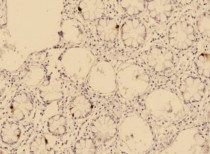ARG66772
anti-Chromogranin A antibody [SQab20205]
anti-Chromogranin A antibody [SQab20205] for IHC-Formalin-fixed paraffin-embedded sections and Human
Overview
| Product Description | Recombinant Rabbit Monoclonal antibody [SQab20205] recognizes Chromogranin A |
|---|---|
| Tested Reactivity | Hu |
| Tested Application | IHC-P |
| Host | Rabbit |
| Clonality | Monoclonal |
| Clone | SQab20205 |
| Isotype | IgG |
| Target Name | Chromogranin A |
| Antigen Species | Human |
| Immunogen | Synthetic peptide within aa. 400-600 of Human Chromogranin A. |
| Conjugation | Un-conjugated |
| Alternate Names | Vasostatin II; CGA; Vasostatin I; Pituitary secretory protein I; SP-I; CgA; SL21; Chromogranin-A |
Application Instructions
| Application Suggestion |
|
||||
|---|---|---|---|---|---|
| Application Note | IHC-P: Antigen Retrieval: Heat mediation was performed in Tris/EDTA buffer (pH 9.0). * The dilutions indicate recommended starting dilutions and the optimal dilutions or concentrations should be determined by the scientist. |
||||
| Positive Control | Colon tissue. |
Properties
| Form | Liquid |
|---|---|
| Purification | Purification with Protein A. |
| Buffer | PBS, 0.01% Sodium azide, 40% Glycerol and 0.05% BSA. |
| Preservative | 0.01% Sodium azide |
| Stabilizer | 40% Glycerol and 0.05% BSA |
| Storage Instruction | For continuous use, store undiluted antibody at 2-8°C for up to a week. For long-term storage, aliquot and store at -20°C. Storage in frost free freezers is not recommended. Avoid repeated freeze/thaw cycles. Suggest spin the vial prior to opening. The antibody solution should be gently mixed before use. |
| Note | For laboratory research only, not for drug, diagnostic or other use. |
Bioinformation
| Database Links | |
|---|---|
| Gene Symbol | CHGA |
| Gene Full Name | chromogranin A |
| Background | The protein encoded by this gene is a member of the chromogranin/secretogranin family of neuroendocrine secretory proteins. It is found in secretory vesicles of neurons and endocrine cells. This gene product is a precursor to three biologically active peptides; vasostatin, pancreastatin, and parastatin. These peptides act as autocrine or paracrine negative modulators of the neuroendocrine system. Two other peptides, catestatin and chromofungin, have antimicrobial activity and antifungal activity, respectively. Two transcript variants encoding different isoforms have been found for this gene. [provided by RefSeq, Sep 2014] |
| Function | [Pancreastatin]: Strongly inhibits glucose induced insulin release from the pancreas. [Catestatin]: Inhibits catecholamine release from chromaffin cells and noradrenergic neurons by acting as a non-competitive nicotinic cholinergic antagonist (PubMed:15326220). Displays antibacterial activity against Gram-positive bacteria S.aureus and M.luteus, and Gram-negative bacteria E.coli and P.aeruginosa (PubMed:15723172 and PubMed:24723458). Can induce mast cell migration, degranulation and production of cytokines and chemokines (PubMed:21214543). Acts as a potent scavenger of free radicals in vitro (PubMed:24723458). May play a role in the regulation of cardiac function and blood pressure (PubMed:18541522). [Serpinin]: Regulates granule biogenesis in endocrine cells by up-regulating the transcription of protease nexin 1 (SERPINE2) via a cAMP-PKA-SP1 pathway. This leads to inhibition of granule protein degradation in the Golgi complex which in turn promotes granule formation. [UniProt] |
| Cellular Localization | Cytoplasmic vesicle, secretory vesicle lumen. Cytoplasmic vesicle, secretory vesicle membrane. Secreted. Note=Associated with the secretory granule membrane through direct interaction to SCG3 that in turn binds to cholesterol-enriched lipid rafts in intragranular conditions. Serpinin: Secreted. Cytoplasmic vesicle, secretory vesicle. Note=Pyroglutaminated serpinin localizes to secretory vesicle. [UniProt] |
| Calculated MW | 51 kDa |
| PTM | Sulfated on tyrosine residues and/or contains sulfated glycans. O-glycosylated with core 1 or possibly core 8 glycans. Proteolytic processing gives rise to an additional longer form of catestatin (residues 358-390) which displays a less potent catecholamine release-inhibitory activity (PubMed:10781584). Plasmin-mediated proteolytic processing can give rise to additional shorter and longer forms of catestatin peptides (PubMed:17991725). [UniProt] |
Images (1) Click the Picture to Zoom In
-
ARG66772 anti-Chromogranin A antibody [SQab20205] IHC-P image
Immunohistochemistry: Formalin/PFA-fixed and paraffin-embedded Human colon tissue. Antigen Retrieval: Heat mediation was performed in Tris/EDTA buffer (pH 9.0). The tissue section was stained with ARG66772 anti-Chromogranin A antibody [SQab20205] at 18°C - 25°C for 30 minutes.






